
Nabis flavomarginatus is a species of damsel bug in the family Nabidae.

Nabis limbatus is a species of damsel bug in the family Nabidae. It is found in Northern Europe and the northern part of Western and Central Europe. It occurs in the East in Eastern Europe and across the Palearctic to Siberia to China and Korea. It is introduced in Canada. In the Alps, it rises to about 1400 meters above sea level. In the South of Europe, it is found only in the central uplands.

Nabis lineatus is a species of damsel bug in the family Nabidae.

Coptosoma scutellatum, the soot sprite, is a species of true bugs belonging to the family Plataspidae, subfamily Plataspinae.

Gonocerus acuteangulatus is a herbivorous species of true bug in the family Coreidae. It is commonly known as the box bug in the UK as it once only occurred in Box Hill in Surrey where it fed on box trees.

Sehirus luctuosus, the Forget-me-not Bug, is a burrowing shieldbug belonging to the family Cydnidae. It is found from Europe to Central Asia.In Central Europe it is widespread and not uncommon. They are found in the Alps on sunny slopes up to almost 2000 meters above sea level.

Neides tipularius is a Palearctic stilt bug. It occurs from the Northern Mediterranean to Scandinavia and the British Isles. Further east it is found in Asia minor and the Caucasus to Central Asia. In Germany and the Alps it is widespread and not uncommon. In Britain it is locally common in large parts of the South. In Ireland it is rare.
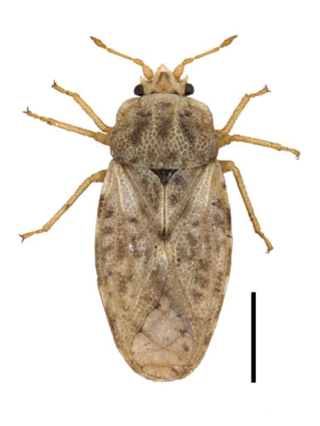
Piesma maculatum is a true bug species found from North Africa to southern parts of Scandinavia and the South of the British Isles then across the Palearctic to the Black Sea region to Central Asia, China and Japan. In Central Europe it is widespread and generally the most common species of the family Piesmatidae.

Macrosaldula scotica is a predatory species of true bug, from the family Saldidae in the order Hemiptera from the western Palearctic.

Metatropis rufescens is a species of true bugs. The species is found in Europe, with the exception of the far North and South then East to the Black Sea region and across the Palearctic to Siberia. In Central Europe it is common, but it is not found everywhere. In the British Isles it is common in the South including Wales and Ireland. It occurs in shady, mostly moist habitats in deciduous forests.
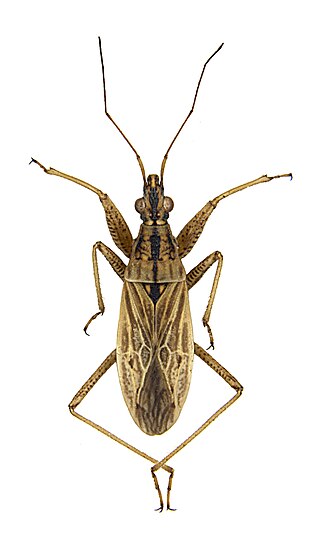
Nabis rugosus, the common damsel bug, is a predatory true bug. The species is found in the Palearctic. It is found in Europe from the North edge of the Mediterranean to southern Scandinavia. Further east, the distribution extends east across the Palearctic to Central Asia and Siberia. The species occurs everywhere in Central Europe and is found in the lowlands, as well as in the central uplands and in the Alps up to about 1500 meters above sea level. It is Central Europe's most common species of sickle bug and it is found in many different habitats, open, dry, shaded and moist; but it prefers moderately moist, half shady places with dominant grass. Adjacent woodland vegetation is equally important.
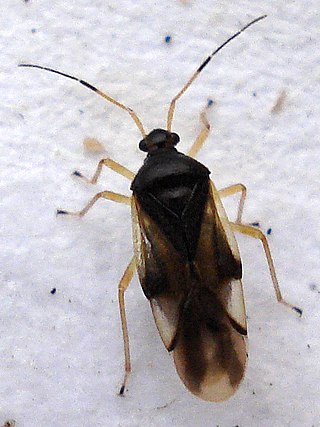
Bryocoris pteridis is a true bug in the family Miridae. The species is found in Europe from Ireland in the West and including the northern edge of the Mediterranean and the East across the Palearctic to Siberia.In Central Europe, it is widespread and occurs both in the central uplands and the Alps up to 1500 metres above sea level.
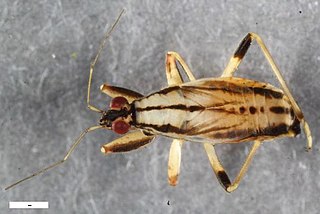
Himacerus boops is a species of damsel bug in the family Nabidae. It is found from South Scandinavia and the South of the British Isles over Western and Central Europe and East across the Palearctic to Siberia and in the Caspian region. They are not present in most parts of the Mediterranean.
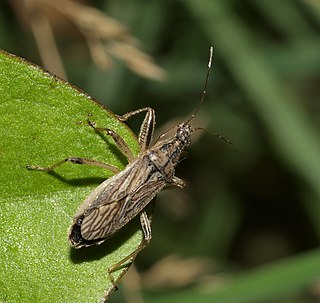
Himacerus major is a species damsel bug in the family Nabidae. It is found in the Holarctic. The range is from South Scandinavia and the South of the British Isles over West Europe including the Western Mediterranean, Central Europe and Eastern Europe and in the Caucasus. It is also found in North America. Himacerus major occurs in many different habitats with grass, regardless of the level of humidity. The species occurs on very dry dune habitats, and nutrient-poor grasslands,as well as wet shores of waters without woody vegetation and salt places inland. The species occurs in very large numbers near the coast of the Northern Baltic Sea. It is absent from woodland.

Drymus brunneus is a species of dirt-colored seed bug in the family Rhyparochromidae found in the Palearctic. In the West Palearctic it is lacking only in the far north of Northern and Eastern Europe. In the East, the species ranges to the Caucasus and Siberia.

Orthonotus rufifrons is a species of plant bugs belonging to the family Miridae.
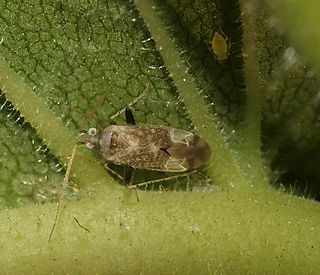
Compsidolon salicellum is a species of plant bug in the family Miridae. It is found in Europe across the Palearctic to Siberia and Korea. It is also found in North America as an Adventive species.

Blepharidopterus angulatus, the black-kneed capsid, is a species of plant bug in the family Miridae. It is found in North Africa, Europe East across the Palearctic to Central Asia and in North America.

Atractotomus magnicornis is a species of plant bug in the family Miridae. It is found in Europe and North America.

Megalonotus praetextatus is a species of seed bug in the family Rhyparochromidae.




















